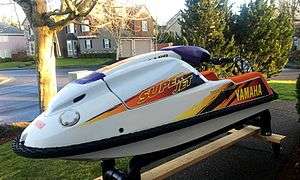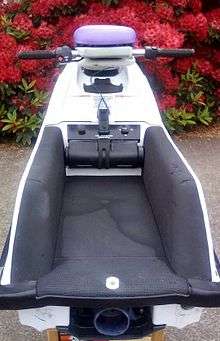Yamaha SuperJet
 A 1996 Yamaha SuperJet, the first year of the 701cc straight twin two-stroke engine with twin Mikuni carburetors | |
| Manufacturer | Yamaha Motor Corporation |
|---|---|
| Also called | SuperJet, 701, Square nose (SN), Round nose (RN) |
| Production | 1990 - present (2017) |
| Assembly |
|
| Class | Personal watercraft |
| Engine |
|
| Bore / stroke | 81 mm × 68 mm (3.19 in × 2.68 in) (SJ700AU) |
| Power | 73hp (SJ700A) |
| Dimensions |
L: 88.2 in (2,240 mm) (SJ700AU) W: 26.8 in (681 mm) H: 26.0 in (660 mm) |
| Weight |
291 lb (132 kg) (SJ700AU) (dry) |
| Fuel capacity | 4.8 U.S. gallons (18 L; 4.0 imp gal), including 1.45 U.S. gallons (5.5 L; 1.21 imp gal) reserve. (SJ700AU) |
| Oil capacity |
|
| Fuel consumption | 7.7 US gal/h (29 L/h) max (SJ700AU) |
The SuperJet is a stand-up type personal watercraft (PWC) made by Yamaha Motor Corporation. Part of Yamaha's WaveRunner line of watercraft, it was introduced in 1990 and has become one of the most successful stand-up personal watercraft ever made.[1] All SuperJets, including the engine, are hand-built in Japan. Credit for the design is given to Clayton Jacobson II.
Prior to the introduction of the new Kawasaki SX-R on October 6, 2016, it has been the only stand-up sold by a major manufacturer since the Kawasaki SX-R 800 was discontinued in 2011.
There are three engine generations spanning 1990-1993, 1994-1995, and 1996-2017, and three hull generations spanning 1990-1995, 1996-2007, and 2008-2017.
The current model SuperJet is powered by a 701cc inline two-cylinder, two-stroke engine.
All generations have an upper and lower hull constructed from SMC (sheet molded compound). SMC is a compression moldable composite material made of long strands of glass fibers suspended in a polyester resin.
SuperJet 1990-1993 (SJ650D,P,Q,R)[Generation 1]
Motor
- Common name: Square nose
- Displacement: 633cc, Inline 2-Cylinder, 2-Stroke (6M6 cylinder, 6M6 cases)
- Rated Power Output: 50 hp
- Premix ratio, gas/oil: 50:1
- Single Carb (Mikuni SBN44) with twin stainless steel 6-petal reed valves
- RPM Limiter: 6500-6600 rpm
Chassis
- Length (in): 86.04
- Width (in): 28
- Height (in): 26.0
- Weight, dry (lb): 287
- Max speed (mph): 38.2
SuperJet 1994-1995 (SJ700S-T)[Generation 1-Upgraded Engine)
The body remains the same as the previous generation with a "Square nose" top deck and standard SuperJet bottom deck.
Motor

- Common name: 701 Square nose
- Displacement: 701cc, Inline two-cylinder, two-stroke (61X cylinder, 61X cases)
- Rated Power Output: 63 hp
- Premix ratio, gas/oil: 50:1
- Single Carb (Mikuni SBN44) with twin stainless steel 6-petal reed valves
- RPM Limiter: 7050-7150 rpm
Chassis
- Length (in): 86.04
- Width (in): 28
- Height (in): 26.0
- Weight, dry (lb): 291
- Max speed (mph): 42

SuperJet 1996-2007 (SJ700AU-BF)[Generation 2]

The body consists of a new "Round nose" top deck (or hull) and the same standard SuperJet bottom deck as the previous "Square nose" model.
Motor
- Common name: 701 or round nose (RN)
- Displacement: 701cc, Inline 2-Cylinder, 2-Stroke (61X cylinder, 62T cases)
- Bore x stroke: 81 x 68mm
- Compression ratio: 7.2:1
- Rated Power Output: 73 hp @6,300 rpm
- Dual carb (Mikuni SBN38) with reed valves
- Premix ratio, gas/oil: 50:1
- Max fuel consumption (US gal/h): 7.7
- Range at full throttle: 0.6 hrs
- Spark plug: B8HS / BR8HS (NGK 6715)
- Ignition Timing: 15° BTDC - 21° BTDC, variable over the RPM range
- RPM Limiter: 7050-7150 rpm
Chassis
- Fuel capacity (gal): 4.8 total, with 1.5 reserve
- Length (in): 88.2
- Width (in): 26.8
- Height (in): 26.0
- Weight, dry (lb): 291
- Max speed (mph): 45.4
SuperJet 2008-2017 (SJ700BG-BS)[Generation 2-Upgraded Hull]

The current SuperJet (produced by Yamaha Motor and hand-built in Japan) has been visually the same since 1996. The 2008 model was the first year of a new bottom deck, changed for the first time in the history of the SuperJet.
This watercraft no longer meets California or New York two-stroke emissions standards as a new vessel (however, previously titled vessels can still be registered in CA).
Purchasing a SuperJet new from a dealer will usually require a license from IJSBA as they are classified as a "competition use only" watercraft due to stringent EPA regulations for two-stroke PWCs. An annual membership from IJSBA is $45 per year as of September 2016.
Body Updates
The new 2008 has the same Roundnose top deck that was introduced in 1996, with a new bottom deck (or hull) incorporating the first changes since 1990 when the SuperJet was released.
The new bottom hull has incorporated side sponsons (similar to adding "Blowsion tubbies") onto the hull. The rear of the hull is also slightly narrower and has deeper strakes for improved tracking.
The handle pole on the 2008 SuperJet is 50 mm shorter than previous generation Roundnose SuperJets.
Mechanical Updates
The intake grate, pump, and ride plate are all set back 50 mm rearward compared to the past SuperJets.
The engine remains the same as the previous 1996+ years with no noted mechanical changes.
The impeller was updated to a new stainless steel design, in comparison to the previous aluminum design that remained the same throughout 1990-2007. The new impeller design offers large improvements in hookup as well as reduced cavitation. The driveshaft was changed to be a constant diameter over the entire length, versus previous years in which it is necked down to a smaller diameter in the center section. However, the impeller is backwards compatible with all older models and can be installed on any year SuperJet from the original aluminum impeller design.
Model Year Cosmetic Updates

- 2008 - 2009 SuperJets are blue with white graphics.
- 2010 - 2011 SuperJets are blue with redesigned white graphics.
- 2012 - 2013 SuperJets are a new black color with orange graphics.
- In 2014, the SuperJet is back in black again, this time with blue graphics.
- 2015 SuperJets retain the same black and blue graphics from the previous year.
- For 2016, the SuperJet SJ700BR is available in two new color options: Pure White with Orange & Blue or Pure White with Black. This is the first time the main body color has been white since 1997.
- For 2017 the SuperJet SJ700BS is available in the same 2016 colors: Pure White with Orange & Blue or Pure White with Black.
Full Specifications
- Rated Power Output: 73 hp @6,300 rpm
- Engine Type: Inline 2-Cylinder, 2-Stroke (61X cylinder, 62T cases)
- Displacement: 701 cc
- Bore x Stroke: 81.0 mm × 68.0 mm (3.19 in × 2.68 in)
- Compression Ratio: 7.2:1
- Carburetion: Twin Mikuni SBN 38 carburetors
- Fuel type: Regular 86 PON (90 RON) unleaded gasoline
- Type of Lubrication: Pre-mixed fuel and oil
- Oil mixing Ratio: 50:1, Yamalube 2-W or TC-W3 equivalent
- Type of Intake: Twin reed valve, stainless steel 8 pedal
- Type of Scavenging: Loop-Charged
- Type of Exhaust: Wet
- Cooling system: Open loop fresh water
- Starting system: Electric
- Ignition: CDI
- Battery capacity: 12 V, 19.0 Ah, Yuasa YB16CL-B
- Spark plug: B7HS/BR7HS (NGK 5110), 0.024–0.028 in (0.61–0.71 mm) gap
- Spark Advance: 6°
- Ignition Timing: 15° BTDC - 21° BTDC, variable over the RPM range
- Trolling speed: 1300 ±50 rpm
- RPM Limiter: 7050-7150 rpm
- Propulsion system: Jet pump
- Jet Pump type: 144 mm axial flow, single stage
- Transmission: Direct shaft drive from engine
- Impeller: 3-Blade stainless steel (13/16 pitch), counterclockwise rotation
- Length: 88.2 in (2,240 mm)
- Width: 26.8 in (681 mm)
- Height: 26.0 in (660 mm)
- Dry Weight: 306 lb (139 kg)
- Total Fuel Capacity: 4.8 U.S. gallons (18 L; 4.0 imp gal)
- Reserve Fuel Capacity: 1.45 U.S. gallons (5.5 L; 1.21 imp gal)
- Maximum Fuel Consumption: 7.7 US gal/h (29 L/h)
- Cruising range at full throttle: 0.62 hour
- Vehicle Capacity: 1 person
- Hull Material: SMC (Sheet Moulded Compound)
- Sold without warranty and for competition use only
- 2016 MSRP: $8,499.00 in the USA, £6,699.00 in the UK, and ¥ 1,009,060 in Japan
- 2017 MSRP: $8,499.00 in the USA
MSRP History By Year

See also
External links
- U.S. Coast Guard Boating Safety
- Personal Watercraft Industry Association
- American Watercraft Association
- X-h2o is a stand-up PWC focused forum, both recreational and professional.
- PWCToday forum discusses all types of PWC's
- Green Hulk Performance is a forum for all types of PWC's, largely focused on the sit-down type
- Yamaha Motors EU SuperJet product page